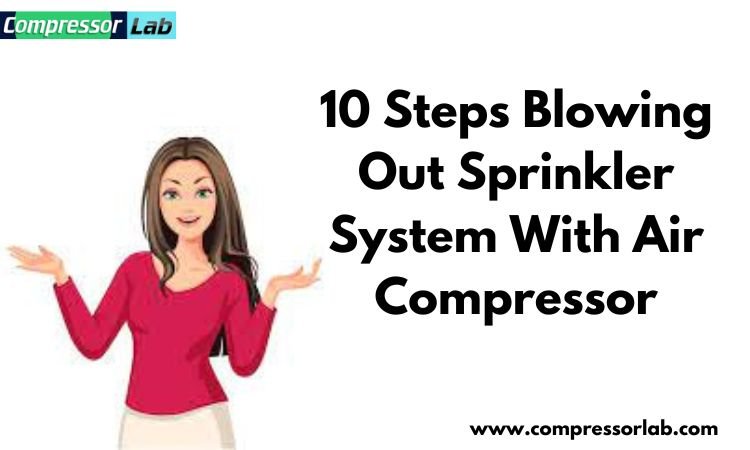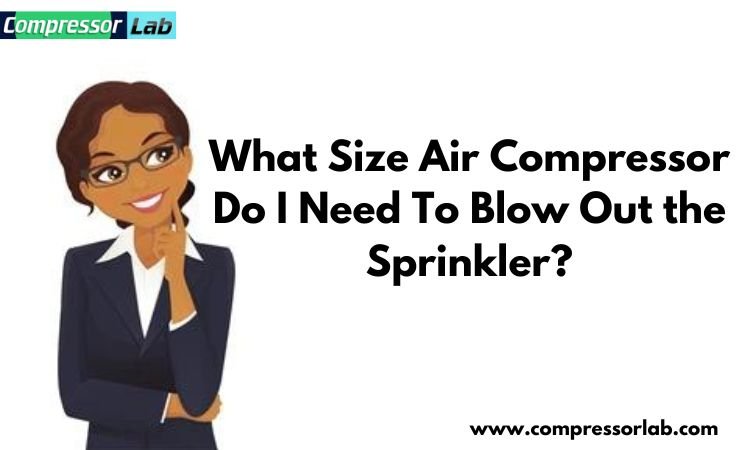
Maintaining your sprinkler system is vital to keeping your garden and lawn healthy and well-kept. One essential step in this process is winterizing your sprinkler system to prevent any damage that can occur during the colder months. Therefore, the standard process for winterizing your sprinkler system is blowing out the water with an air compressor. However, this process can be daunting, especially for new ones. In this guide, I will walk you through the steps to blow out your sprinkler using a compressor. And it will ensure that your system is properly winterized and ready for the colder months ahead.
So, let’s dive straight into it and find out how to blow out the sprinkler system with an air compressor in the section below–
10 Steps Blowing Out Sprinkler System With Air Compressor

Here I will specify the whole process in a few straightforward steps. Check this section out–
Step-1: Shut Off The Water Provide
Before using an air compressor to clear out any remaining water from your irrigation system, shutting off the water supply and draining the pipes is essential. Although turning off the water will mostly clear out the system, relying solely on natural draining can leave some water remaining.
Therefore, it’s best to use pressurized air after the natural draining to ensure the system is adequately cleared.
Step-2: Release Pressure
After turning off the water to your irrigation system, open the hose bib on the mainline of the sprinkler to release pressure and allow air to drain the water from the pipes naturally. This step will prevent water from remaining in the lines over winter.
However, depending on the system’s size, the drainage process may take a few minutes. It can help avoid costly maintenance for larger systems. After the pipes have drained, proceed with blowing out the system.
Read also
Top 10 Best Air Compressor For Cleaning PC: A Definitive Guide(Opens in a new browser tab)
Oil vs Oil-free Air Compressor: Which Is Best & Why? (Opens in a new browser tab)
How To Drain Air Compressor? Tips & Tricks(Opens in a new browser tab)
How To Remove Water From Air Compressor? Ultimate Guide(Opens in a new browser tab)
How To Inflate A Pool With An Air Compressor? (5 Steps Guide)(Opens in a new browser tab)
Step-3: Prep Compressor
Before blowing out your sprinkler system, drain all water from the pipes. Then you’ll need an air compressor, and the recommended PSI depends on the type of pipes.
For example, PVC uses 80 PSI; black polyurethane use 50 PSI. Also, you can follow the compressor’s owner manual for guidelines on how to place it up. If you have an extensive system, use a portable compressor to work on one zone at a time.
Step-4: Connect The Hose
Now connect the hose to the bib on the mainline of the sprinkler system, and use an adapter if necessary to ensure the fittings align correctly. And checks the attachment is secure and free of air leaks to maintain intense air pressure.
Therefore, the air compressor and its attachments must perform at total capacity to properly clean the irrigation system pipes.
Step-5: Start Compression
After connecting the compressor with the irrigation, start the compressor. And blow out the farthest sprinkler first, using the system timer to activate the sequence. It will ensure that your setup is sufficient for the whole task.
If your system is spread out across high and low levels, start with the higher zones to test the compressor’s settings and hose attachment. And you can make adjustments if needed.
Step-6: Stop Backflow
After that, switch off the backflow valves and switch on the compressor valve. Let the air flow steadily through the system, taking time to pass through the pipes, spouts, and joints. After the process, there may be wet spots on the lawn and debris dispersed in various places.
In addition, be cautious of debris that might move during the process, and wear safety goggles when near sprinkling outlets. Be extra careful if there is a pile-up of debris or foliage in dense concentrations in the yard.
Step-7: Monitor Blowout
While conducting the blowout, keep an eye on the pressure gauge to ensure it doesn’t exceed the machine’s maximum level. The goal is to remove all obstructions from the irrigation system. So that the airflow becomes quieter and the pressurized air flows freely through the sprinkling outlets.
Once the farthest zone is complete, move on to the next area inward and repeat the process.
Step-8: Move In The Zone
After blowing out the first zone, move to the next one and repeat the process, taking about the same time. Watch and listen carefully during the second blowout, checking the pressure levels on the monitor. However, the process might be more intense if more trapped water was in the second zone. Wait until only compressed air comes out of the sprinklers before moving on to the following location.
Next, once you finish the second zone, moving to the third zone is easy. Let pressurized air enter the system and monitor sprinklers for water spouts that indicate successful pipe clearing. And check the air compressor monitor to avoid exceeding maximum pressure. However, each zone should take about two minutes to clear; some can require repeating the process.
Step-9: Stop On Time
Once blowing out a zone for at least two minutes, the sprinklers should have no water left. Once all the applicable sprinklers stop blowing out water, stop the blowout process to avoid damaging dry pipes. And this will ensure your lines are safe during winter and will work properly when you use them again in the spring.
Step-10: Disconnect And Finish Up
When finishing the irrigation system blowout, disconnect the hose and air compressor. Release any remaining air pressure in the line to avoid future problems.
Then unplug and store the compressor and place the hose in its storage. Finally, consult the equipment manuals for any additional steps needed.
What Size Air Compressor Do I Need To Blow Out the Sprinkler?

Regarding blowing out sprinklers, a question often asked is whether an air compressor can be used to blow out the sprinklers. If you possess an air compressor with a cubic foot per minute rating between 80 CFM and 100 CFM, the answer to this question is yes.
However, you will need to conduct this process on a zone-by-zone system. And many of the reciprocating compressors available in the Quincy line are appropriate for winterizing irrigation systems of different sizes.
Final Words
Before winter, it’s the most frequent question of how to blow out the sprinkler systems with an air compressor. The process is relatively simple and requires a few essential tools, but it can save you from costly repairs in the future. Following the steps mentioned in this guide, you can ensure your sprinkler system will protect from freezing temperatures and be ready to use again when the weather warms up. Therefore, take safety precautions when working with an air compressor, and follow the user’s instructions carefully.
FAQs
How much CFM to blow out sprinklers?
The required CFM (cubic feet per minute) to blow out sprinklers depends on the size and irrigation system. Generally, a CFM of 80-100 is sufficient for residential sprinkler systems, while larger commercial systems may require a CFM of 200 or more.
Can I blow out my sprinklers with an air compressor?
Yes, you can blow out your sprinklers with an air compressor. It is a common and effective method of winterizing your irrigation system to prevent freezing and damage during the colder months. However, following the user’s manual and using the appropriate air pressure is crucial to avoid harming the sprinkler components.
How strong of an air compressor do I need to blow out sprinklers?
The strength of a compressor required for blowing out sprinklers is based on the system’s size and the number of zones. A minimum of 5 cubic feet per minute (CFM) compressor at 80 PSI should be sufficient for most residential systems. However, larger commercial systems may require a compressor with a higher CFM rating.
Where do you put a compressor to blow out sprinklers?
The ideal location to place a compressor for blowing out sprinklers would be near the sprinkler system’s main shut-off valve. It will allow easy access and prevent compressor or sprinkler system damage.
How do I drain my sprinkler system?
First, turn the water supply off the system to drain a sprinkler system. Then, open all the valves and drain points, allowing the water to flow out. And removing all water from the system is essential to prevent freeze damage during the winter. Hence repeat the process until there’s no more water left.


Recent Comments